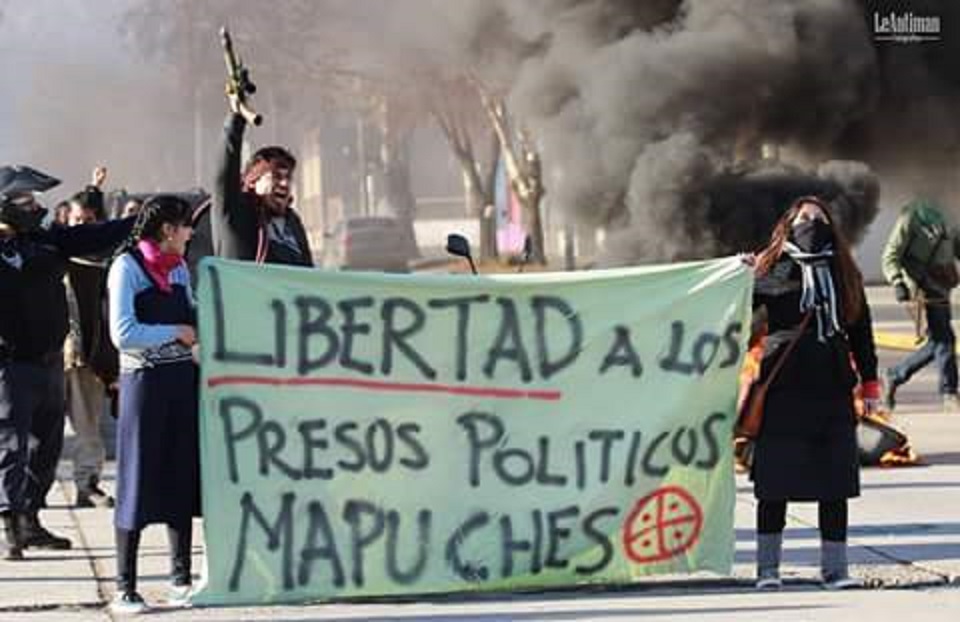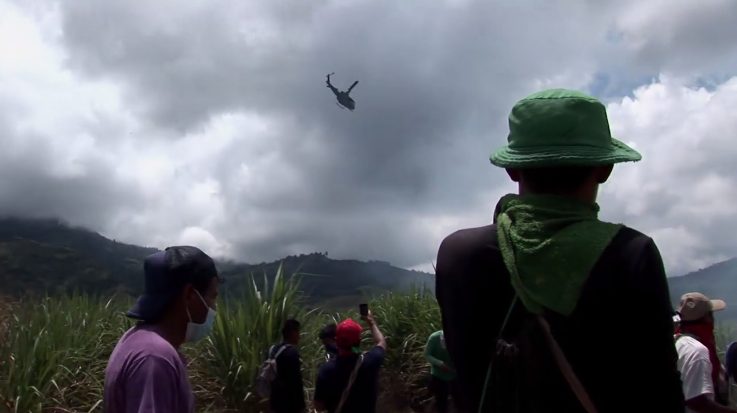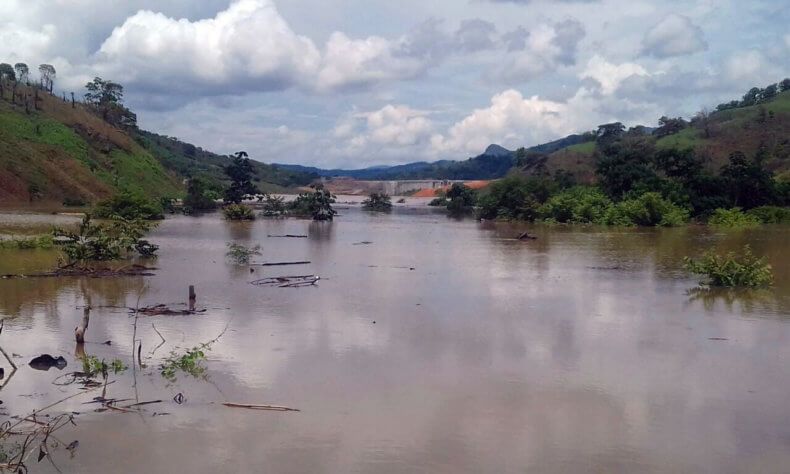
The Mapuche’s Cross-border Struggle for Freedom and Autonomy from Argentina and Chile
by Deep Green Resistance News Service | Oct 9, 2016 | Indigenous Autonomy, Repression at Home
by Alejandra Gaitan Barrera and Fionuala Cregan / Intercontinental Cry
Ever since the incursion of rampant neoliberalism in Chile and Argentina in the 1970s and 1980s, the Mapuche territory or Wallmapu, located south of the Bio Bio River, has been subjected to immeasurable domination and constant exploitation at the hands of a diverse range of foreign and national economic interests. Megaprojects like hydroelectric dams, mining operations, oil extraction and forestry plantations embody some of the main threats to Mapuche self-determination and autonomy.
In Chile, thanks to the enactment of Law 701 in 1974, three forestry giants stand at the forefront of the exploitation of Mapuche territory Forestal Bosques Arauco, CMPC and Forestal Mininco. Overall, pine and eucalyptus plantations in Chile today amount to more than 2.8 million hectares. For their part, the forefathers of today’s latifundistas were European-born families, who were invited to settle in Mapuche territory during Pinochet’s dictatorship.
Underpinning the vast array of threats in Wallmapu there sits a broader historical, socio-politico and economic reality that was recently defined by historians Fernando Pairican and Rolando Alvarez-Vallejo as the “New Arauco War”.
On the frontlines of this war, the Chilean State works vigorously to criminalize, demoralize, incarcerate and discredit Mapuche leaders using any manner or method at their convenience.
A prime and recent example of this harsh campaign can be found in the arbitrary detention of Mapuche Peñis, Ernesto Lincoyam Llaitul Pezoa and Ismael Queipul Martínez, by Chilean security forces last May, in Los Angeles (Bio Bio Region).
Peñi Llaitul was arrested due to the alleged illegal possession of firearms — although no concrete evidence for this accusation has since then been provided by Chile’s equivalent to the FBI, the Investigations Police of Chile (PDI). His arbitrary detention can be best explained as part of the regular series of intelligence operations against the Mapuche — constant monitoring and surveillance of Mapuche autonomist communities by undercover police, paramilitaries and co-opted local members has indeed become an entrenched strategy of the Chilean corporate state.
Most importantly, the violent arrest of Llaitul and Queipul came at a crucial juncture in Chilean-Mapuche politics. In the leading up to the first ever Mesa de Diálogo, a top-down embraced initiative to reconcile Mapuche and non-Mapuche interests in the region, the Arauco Malleco Coordinating Committee (CAM for its Spanish acronym) publicly announced its refusal to participate. The announcement sparked anger and frustration among the politically liberal associations and NGOs that sought a peace process. The rationale behind CAM’s decision was that the Mesa de Dialogo was largely devoid of political power since it was pushed by local and national actors which had themselves a vexed interest in the negotiations, such as conservative intellectuals, university chancellors, forestry and mining labor union leaders, among others. Unsurprisingly, the corporate giants absented themselves from the table. In this sense, the Mesa de Dialogo was an attempt to paradoxically reconcile Mapuche and non-Mapuche interests by leaving capital untouched.

Mapuche activist Ernesto Llaitul was arrested by Chilean police on weapons charges in 2016. Photo by Periódico Azkintuwe.
This refusal to partake in the Mesa de Dialogo and any other similar de-politicized, de-economized processes came along with the release of a first of its kind mainstream special television report on CAM and its clandestine strategy of liberation. This report showed for the first time to the average Chilean citizen an unapologetic CAM, which openly defended violence (arson and other attacks against capital) as the sole means of emancipation–leaving the variegated cells of CAM exposed to a wave of brutal quelling, which included arbitrary arrests, violent raids to communities and the expulsion of Mapuche from recovered lands. It was precisely in this critical environment where Llaitul and Queipul were arrested.
For his part, Ernesto Llaitul has been a long-time active member of CAM. His father, Weychafe Héctor Llaitul has been at the forefront of Mapuche resistance since the late 1990s. Therefore, his arrest comes as no surprise to the Mapuche communities of Arauco-Malleco. He is another de facto political prisoner jailed in Wallmapu. In the midst of his imprisonment, Ernesto Llaitul proclaimed “neither imprisonment nor bullets will halt our struggle”.
On Wednesday 21 of September, the Los Angeles tribunal ruled Ernesto Llaitul’s detention arbitrary and illegal. Preventive detention was revoked and he has since been granted partial parole. The tribunal states that insufficient evidence was provided by the prosecutors to proof Llaitul and Queipul’s illegal possession of weapons. This development, however, should not be construed as the triumph of justice in the highly-corrupted Chilean bureaucratic-legal system. On the contrary, it sheds light on the variegated and complex techniques of oppression and surveillance used by the Chilean state. It is through arbitrary arrests, like this one, that the Chilean state exudes the extent of its power. It is through granting parole that it aims to wash off international condemnation of its judicial processes. The release of Llaitul can only be seen as a statist tool to “pacify” and co-opt CAM.
A similar narrative of criminalization can found in nearby Argentina.
Most recently, on August 30 2016 a large contingent of police and military personnel took to the streets of city of Esquel in Patagonia, Argentina where Mapuche leaders and social movement gathered outside the courthouse to support Lonko (traditional leader) Facundo Huala Jones.

Mapuche activists outside protested outside a courthouse on August 30 2016 in the city of Esquel in Patagonia, Argentina to support Facundo Huala Jones. Photo by Red de Apoyo Comunidades en Conflicto MAP
In preventative detention since May 27, 2016, Huala was accused of usurping land belonging to the multi-national Benetton in Chubut, Argentina and also faced extradition to Chile where he is wanted on counts of arson and possession of illegal weapons in a case dating back to 2013 in Pisue Pisue, Rio Bueno.
Huala Jones had no doubts about his situation: “I am a political prisoner, persecuted by the Government of two countries – Argentina and Chile,” he said. “This is political persecution that goes beyond this judicial process.’
This could not have been clearer when the Judge Martin Zacchino refused a request from Huala’s defence lawyer to allow him to go under house arrest on health grounds: “You incite people to fight, that verges on crime. 30 more days in prison,” he said.
The case of Peñis, Huala Jones and Llaitul both need to be contextualized within the broader warfare campaign targeting Mapuche leaders —from Machis (spiritual healers) to Werkens (messengers) and Weychafes (warriors) — all of them, struggling for the inherent right to autonomy of the Mapuche nation.
Unlike many other indigenous nations in South America, the Mapuche nation continued to be autonomous fiercely and successfully resisting any incursions on their territory up until the late nineteenth century. It wasn’t until the foundation of the colonial nations of Argentina and Chile, that the Wallmapu was divided in two and differing forms of oppression ensued.
In Chile, the Mapuche nation was forcibly annexed in the aftermath of the violent and brutal Operation “Pacificación de la Araucania”.
In Argentina, a campaign of genocide called the ‘’Conquest of the Desert’’ rampaged from 1778-1885, killing and enslaving the Mapuche, funded partly by the British who supplied Remington Rifles in return for 1 million hectares of land. Up until the mid 1920s, money was awarded to anyone who presented the ear of a slain Mapuche — a process which enabled many European settlers buy up land.
Despite this, the Mapuche never lost their vision of an autonomous Wallmapu and have maintained their historic fierce resistance to the colonial states. Today, the Arauco Malleco Coordinating Committee and the emerging Movimiento Autónomo del Puelmapu (MAP) in Argentina are arguably the most important indigenous autonomist organization in the whole of Latin America engaging in a project not only for the recovery of scattered Mapuche lands but actively seeking to liberate the Mapuche nation from the grip of statist colonial power and its corporate allies.

The heavy police presence on the streets of Esquel during the trial of Facundo Huala. Photo by Red de Apoyo Comunidades en Conflicto MAP.
“We have a legitimate right to rise up and rebel in the face of tyrannical regimes, created through processes of military occupation by the Chilean and Argentinean government from the mid-1800s onwards which created poverty, violence, racism, denial of basic human rights and a policy of genocide which exists even today,” says Huala, “And even more so when there is no serious attempt at dialogue. The response to our political proposals is always the same: prison and bullets.”
The imprisonment of Mapuche leaders raises serious concerns of due process in a country which has long been regarded as the epitome of Latin America’s liberal democracy.
Take, for instance, the highly controversial imprisonment of Machi Francisca Linconao and Machi Celestino Cordova, who were charged with terrorism due to their supposed involvement in the arson attacks against the estate of the Luchsinger family in 2013. Their trial was marred with inconsistencies, lack of transparency and heavily relied on protected “faceless” witnesses, all of this validated and substantiated by Chile’s 1984 Anti-Terror Law—a controversial piece of legislation that dates back to Pinochet’s time. While the original law was first and foremost directed at targeting and quelling the more “direct” actions of leftist urban guerrillas in the 1980s , the amendments to this law passed by the Chilean Congress after the restoration of democracy post-1990s aimed to legalize the systematic surveillance of Mapuche communities, the militarization of Wallmapu and the inclusion of arson attacks as a terrorist act.
In Argentina the process of judicial harassment of Mapuche leaders has been less extreme than in neighboring Chile. One reason given by the MAP is the history of extreme violence against the Mapuche: “ Here we have dead bodies, not prisoners, ” they say.
And this violence could clearly be seen during the arrest of Huala Jones on 27 May 2016 in a police raid in Cushaman, a community which is in the process of land recuperation from the multi-national Benetton. 120 heavily armed police used bullets, tear gas and destroyed the homes of a group of 20 people living on 500 hectares of recovered land. Six others were arrested but subsequently released, with the existing extradition request from Chile used to justify preventive detention for Huala.
The request dates back to 2013 when Haula had been visiting Machi Millaray Huichalaf — an emblematic figure in the struggle against a hydroelectric dam on the Pilmaiken River — when her house was raided by police and she was arrested along with Facundo and four other colleagues all accused of involvement in an arson case on the agricultural estate Pisue Pisue. During a year long process of judicial persecution involving preventative detention, home arrest while the Chilean Government sought ways to apply the anti-terrorist law to this case, Huala managed to escape back into Argentina. While the intellectual authors of the arson were never found, Machi Millaray was sentenced to two months in prison, the other four were absolved and Huala was declared a fugitive of justice.
As aforementioned, Ernesto Llaitul’s father, Weychafe Hector Llaitul, has been a central actor in the Mapuche resistance movement since the late 1990s. Therefore, he has been subjected to the same controversial legislation and undue process. Weychafe Llaitul, current leader and spokesperson of CAM, was charged for the attacks against prosecutor Mario Elgueta back in 2008.
While Weychafe Llaitul is now on parole, his struggle for the revindication of Mapuche territory and the liberation of the Mapuche Nation continues unscathed. Intimidation, infiltration and violent attacks by corporate-funded paramilitaries — such as the Comando Hernán Trizano — continues, limiting the processes of territorial recuperation set into motion by CAM.
Llaitul’s imprisonment then evinces the perpetuation of arbitrary and undemocratic Chilean legal processes that continue to criminalize Mapuche mobilization and persecute prominent Mapuche leaders and activists.
A surprise move unsettles the status quo on the other side of the colonial border. On August 31, 2016, Argentinean authorities chose not to grant Chile its extradition request of Huala. The testimony of one of the witnesses brought forward by the prosecution was called into question after he claimed that he had been forced to sign a statement of accusation against Huala.
The revelation was key in the Judge’s final decision that was met with an explosion of excitement and the Mapuche battle cry Mariciweu!
“Historically, the Government has always ruled against Indigenous people,” said Qom leader Felix Diaz who attended the trial. “Today a precedent has been set which gives us hope of a new future for Indigenous people.”
For now, Huala while will enjoy time with his family and loved ones and the struggle will continue: “In prison or out, I will always fight. When things are wrong we have to change them. When you see oppression and do nothing to change the situation, then you become complicit with the oppressor.”
Ernesto Llaitul and Ismael Queipul, meanwhile, continue to face persecution along with so many other Mapuche men and women who seek only to preserve the lands and rights of their ancestors.
Until both states choose to embody the democratic values they espouse and, most importantly, halt the unrestricted incursion of capital agents in the region that process will continue to play out as it always has, shedding more and more light on the extent of the political repression and economic subordination in both Chile and Argentina.







